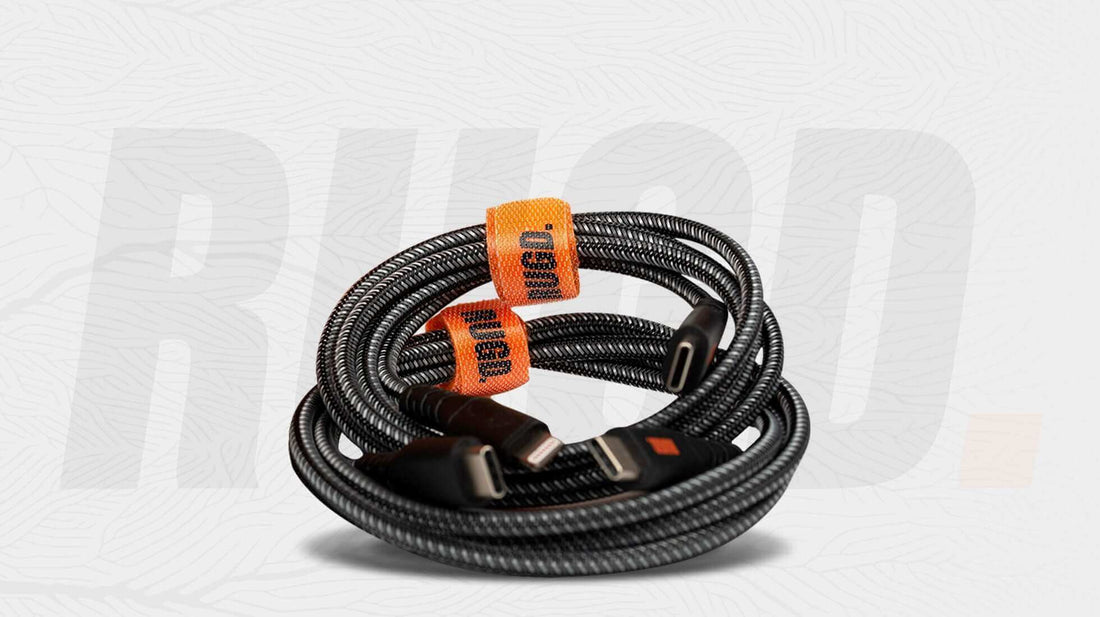
Tips for Properly Coiling and Storing Charging Cables
Share
Importance of Proper Cable Management
In our tech-driven lives, charging cables are essential. From smartphones to laptops, these cords keep our devices powered up. However, tangled and damaged cables are a common annoyance. Proper cable management is not just about avoiding a mess; it's about maintaining the functionality and longevity of your cables.
Overview of Common Problems with Charging Cables
Charging cables often face issues like fraying, internal wire breakage, and connection failures. These problems arise due to improper handling, storage, and coiling. Learning how to manage your cables properly can prevent these issues and extend the life of your cables.
The Basics of Charging Cables
Types of Charging Cables
Charging cables come in various types, including USB-A, USB-C, Lightning, and Micro-USB. Each type has different uses and compatibilities, and knowing which type you have is crucial for proper handling.
Materials and Durability
Cables are made from materials like plastic, rubber, and braided nylon. Braided cables tend to be more durable, while plastic ones are more prone to damage. Understanding the material of your cable can help you determine the best storage method.
Why Proper Coiling is Important
Preventing Damage and Fraying
Improperly coiled cables can lead to kinks and fraying, which weaken the internal wires. This damage can result in slower charging speeds or complete cable failure.
Extending the Lifespan of Cables
By coiling your cables correctly, you can significantly extend their lifespan. This not only saves you money but also reduces electronic waste.
Step-by-Step Guide to Coiling Charging Cables
Gather Your Cables
Before you start coiling, gather all your charging cables. Identify different types and lengths, as this will help you choose the best coiling method for each one.
Straighten the Cable
Remove any tangles and knots from the cable. Straightening the cable ensures that it coils neatly and prevents future tangling.
The Over-Under Method
This method involves coiling the cable in alternating loops, which helps prevent twists and kinks.
- Hold the cable in one hand.
- Make a loop in one direction.
- Make the next loop in the opposite direction.
- Continue this pattern until the entire cable is coiled.
The Figure-Eight Method
The figure-eight method is excellent for longer cables as it distributes tension evenly.
- Hold the cable in both hands.
- Form a loop in the shape of an eight.
- Continue looping in this pattern until the cable is fully coiled.
Storing Your Coiled Cables
Using Cable Ties and Organisers
Cable ties are a great way to keep your coiled cables neat. Velcro ties are preferable as they are reusable and gentle on the cables.
Cable Storage Boxes
Cable storage boxes can keep your cables organised and protected. Look for boxes with compartments for different cable types and lengths.
DIY Cable Storage Solutions
You can create your own storage solutions using household items. Toilet paper rolls, bread clips, and binder clips can all be repurposed to store cables neatly.
Best Practices for Long-Term Storage
Avoiding Extreme Temperatures
Extreme temperatures can damage the materials of your cables. Store them in a cool, dry place to maintain their condition.
Keeping Cables Away from Direct Sunlight
Sunlight can degrade the materials of your cables over time. Store them in a shaded area to prevent this damage.
Using Desiccants to Prevent Moisture Damage
Moisture can cause internal damage to cables. Use desiccants (like silica gel packets) in your storage containers to absorb excess moisture.
Common Mistakes to Avoid
Tight Coiling
Coiling cables too tightly can cause internal wire damage. Always leave a bit of slack in the loops to avoid this issue.
Using Inappropriate Storage Materials
Avoid using materials that can cause static or physical damage to your cables. Stick to soft, non-abrasive materials for storage.
Maintaining Your Charging Cables
Regular Cleaning
Keep your cables clean by wiping them down with a damp cloth regularly. This prevents dirt buildup that can damage the connectors.
Inspecting for Wear and Tear
Regularly inspect your cables for signs of wear and tear. Early detection can prevent further damage and potential device harm.
Eco-Friendly Cable Management
Recycling Old Cables
Don’t throw old cables in the trash. Many electronics stores and recycling centres accept cables for proper recycling.
Choosing Sustainable Storage Solutions
Opt for storage solutions made from sustainable materials. Bamboo cable organisers or recycled plastic storage boxes are eco-friendly options.
Troubleshooting Common Cable Problems
Frayed Ends
If your cable ends are frayed, it's time to replace them. Temporary fixes like electrical tape can work, but they are not long-term solutions.
Bent Connectors
Bent connectors can often be straightened carefully with pliers. However, if the damage is severe, replacement is necessary.
Slow Charging Issues
Slow charging can be due to a damaged cable or a faulty power source. Try using a different cable or charger to identify the problem.
Conclusion
Properly coiling and storing your charging cables can prevent many common issues and extend their lifespan. By following these tips, you can keep your cables neat, functional, and ready to use whenever you need them. Remember, a little effort in cable management goes a long way in maintaining your tech gear.
FAQs
How often should I replace my charging cables?
It's best to replace your charging cables as soon as you notice significant wear or if they no longer charge your devices efficiently.
Can I use any type of cable tie for my cables?
Velcro cable ties are recommended as they are reusable and less likely to damage your cables compared to plastic zip ties.
What is the best way to clean charging cables?
Use a damp cloth to gently wipe down your cables. Avoid using harsh chemicals as they can damage the cable's material.
Are there specific storage boxes for different types of cables?
Yes, some storage boxes are designed with compartments for various cable types, making it easier to keep them organised.
How can I tell if my cable is damaged?
Signs of damage include frayed ends, bent connectors, and inconsistent charging performance. Regular inspection helps in early detection of such issues.

